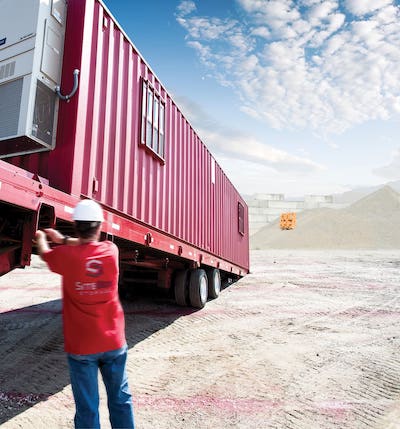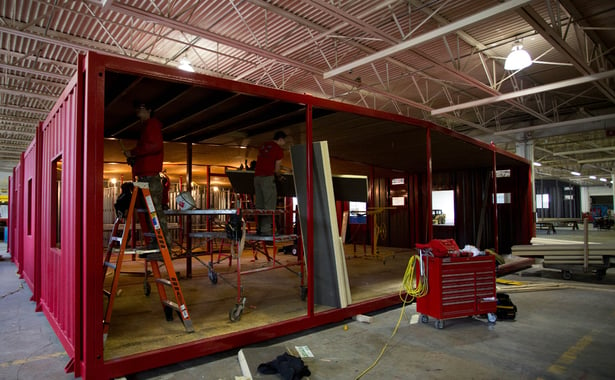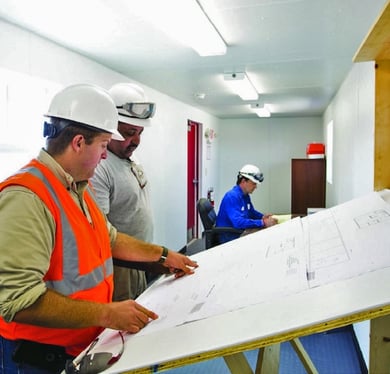Seven things you didn't know about mobile offices

Most business owners have heard of portable offices by now. Construction companies use them. Renovation contractors use them. Mobile sales teams use them. But a lot of people still have outdated ideas or straight-up misunderstandings about what these things actually are.
The storage industry's come a long way from those damp, drafty garage-style units from years ago. Today's portable storage is secure, waaterproof, and comes with tons of options. Mobile offices have evolved the same way. These aren't the flimsy trailers your dad complained about in the 90s.

Modern mobile office trailers are legitimate workspace solutions that solve real problems for businesses across industries. About 72.4% of construction companies use mobile offices on-site because they work. The global market for portable offices grew by 5.3% in 2024, and portable offices reduce project downtime by approximately 18.6%.
Here are seven things you probably didn't know about mobile and portable offices.
Types of Mobile and Portable Offices
Mobile offices come in several types depending on needs. Standard office trailers are self-contained units with desks, power outlets, and climate control for construction sites and temporary locations.
Modular buildings are more substantial structures that link together for larger complexes. Schools use these as temporary classrooms. Businesses set them up as semi-permanent administrative buildings. The modular design configures however you need.
Combination units split space between office and storage. Half functions as workspace, half stores tools or inventory. Construction sites use these so managers have office space while crews have secure storage in one unit.

Specialty configurations exist for specific industries—classrooms for education, administrative offices for healthcare, sales offices for retail. You pick what fits instead of making a generic unit work.
Key Features and Benefits
Modern portable offices include electrical outlets for computers and equipment, HVAC systems for year-round climate control, and proper lighting throughout. About 64.9% are equipped with high-speed internet connectivity—Ethernet ports, WiFi, phone lines. Your team works as effectively as in traditional offices.

Security features include reinforced windows, steel doors, integrated locks, and welded lockboxes. Fire safety equipment like smoke and CO2 detectors with extinguishers come standard.
Benefits include flexibility for workspace exactly where needed, 3.7-day average setup time versus months for traditional construction, and cost-effectiveness on rentals and purchases. You're not locked into long-term real estate decisions.
Materials and Construction Quality
Steel construction provides durability and security that wood-framed units can't match. Treated steel resists corrosion and weather while providing structural integrity for years of use.

Quality insulation in walls, ceilings, and floors keeps temperatures comfortable and reduces energy costs. This matters for year-round use from Alaska's cold to Arizona's heat or Michigan's snow to South Carolina's humidity.
Reinforced flooring handles office furniture and equipment weight without damage. Windows are reinforced glass, often with security bars, letting in natural light while maintaining security. Steel doors have proper weather seals and integrated locks.
With proper maintenance, quality mobile offices serve for many years across multiple projects from Chicago to San Francisco.
Extensive Customization Options
You can customize size based on space requirements and team size. Common sizes are 10, 20, and 40 feet, with custom specifications available.
Internal layout configures exactly how you need it. Open floor plans, separate offices, meeting rooms, break areas with kitchens, storage sections—you design for how your team works.
Amenities include restrooms, kitchen areas, specialized equipment hookups, or classrooms for education. Exterior modifications add steps, ramps for accessibility, awnings, and lighting. Branding lets you paint in company colors or add logos.
Furniture can be included—complete setups with desks, chairs, filing cabinets, and shelving—or you furnish it yourself.
Mobility and Transportation Advantages
Modern mobile office trailers are designed for transportation between project sites, relocated as needs change, or repositioned on property. You don't handle this—the provider delivers on specialized trucks, positions where you want it, and handles pickup when done.
For businesses in multiple locations, this mobility is invaluable. Construction companies move offices between job sites. Event companies transport units to venues. Seasonal businesses relocate without maintaining permanent facilities everywhere.

Transportation needs a lane 50 to 100 feet long, 12 feet wide, with 17 feet vertical clearance. Ground must be stable and level. Parking lots, vacant lots, and city streets work with permits.
States like Michigan, Maine, Rhode Island, Minnesota, Kentucky, Tennessee, Maryland, New Hampshire, New Mexico, Louisiana, New Jersey, Massachusetts, and Alaska have different permit requirements. Check local rules—providers handle delivery logistics.
Quick Installation and Setup Process
Setup speed is a massive advantage. Traditional construction takes months. Mobile solutions average 3.7 days from delivery to fully operational.
Delivery happens on your schedule. The truck arrives, positions the building, sets it in place. Ground-level units sit on prepared surfaces. Utility connections follow—electrical, internet, phone lines. Restrooms or kitchens get plumbing connected to existing systems.
Interior setup depends on arrival configuration. Some come fully furnished and ready immediately. Others need furniture installed. Either way, days not months. Your team starts working right away.
This speed reduces project downtime by approximately 18.6% compared to traditional construction. Getting workspace operational fast has real value when every delay costs money.
Energy Efficiency and Sustainability Benefits
Modern mobile offices are surprisingly energy efficient. Proper insulation keeps heating and cooling costs reasonable. HVAC systems are appropriately sized for the space. LED lighting reduces electrical consumption.
The temporary nature has sustainability benefits. Instead of building permanent structures you might not need long-term, you use temporary workspace exactly as required. No wasted materials on buildings sitting empty later.
Many modular buildings get reused across multiple projects and locations. One unit might serve construction sites, then classrooms, then administrative offices. This reuse reduces environmental impact versus building new structures every time.
Solar panels, rainwater collection, and low-flow plumbing are available options for environmentally conscious businesses.
Common Uses and Applications
Mobile office trailers work across tons of industries. About 72.4% of construction companies use them on-site for jobsite management. Project managers need workspace for plans, computers, meetings, and administrative tasks where work happens.

Education facilities use portable classrooms for overcrowding, renovations, or enrollment growth. Schools add classroom space quickly without permanent construction taking months.
Healthcare facilities use them during expansions when construction disrupts operations. Retail and sales operations set up temporary locations at markets and events. Manufacturing sites use them for supervisors. Government projects use them for site management.
Event companies use them as command centers or ticket booths. The range of applications keeps expanding as businesses discover mobile solutions often work better than traditional approaches for temporary situations.
Cost Considerations and Budget Planning
Mobile offices offer significant savings versus traditional construction. Renting runs a few hundred to a couple thousand monthly depending on size and features. Purchasing costs a fraction of permanent construction.
Rental works for short-term projects or uncertain timelines. Monthly costs stay manageable as operating expenses. Contract terms are usually flexible—month-to-month or longer.
Purchasing makes sense for long-term use across multiple projects. Higher upfront cost but lower lifetime expense than renting indefinitely. You can sell used units later if needed.
Lease-to-own bridges both approaches. Monthly payments while using, eventual ownership. Good for spreading costs over time for cash flow management.
Factor in delivery, setup, utilities, permits, and customization for complete budgets. Get detailed quotes showing all costs to compare properly. The cost-effectiveness versus traditional construction is substantial—tens of thousands and months versus days at a fraction of the cost.
Maintenance and Long-Term Durability
Quality mobile office trailers last years with proper maintenance. Steel construction handles weather and daily use without deterioration seen in wood structures.
Basic maintenance is straightforward. Keep exterior clean. Check door seals and weather stripping periodically. Inspect roofs after storms. Ensure drainage stays clear.
HVAC needs filter changes and annual servicing. Electrical systems need periodic inspections. Plumbing in units with restrooms or kitchens needs standard attention.
Interior maintenance depends on use. Clean regularly. Address damage promptly. Keep organized. Treat it like any office.
When renting, providers often handle maintenance per contract. When purchasing, it's yours to handle, but requirements aren't burdensome with basic upkeep.
A well-maintained mobile office serves construction companies across dozens of job sites over a decade. Schools use portable classrooms for multiple years. Investment pays off through repeated use.
Frequently Asked Questions
What is a mobile office? A mobile office is a fully functional workspace built into a transportable structure designed for temporary or relocatable use. Modern units include desks, electrical systems, climate control, internet connectivity, and office amenities comparable to traditional buildings. They're designed to be moved between locations as business needs change.
What is a portable office? Portable office is essentially synonymous with mobile office—both terms describe modular buildings designed for temporary or relocatable workspace solutions. The "portable" emphasizes they can be easily transported and set up at different locations as business requirements change without permanent construction.
What are the benefits of mobile offices? Key benefits include flexibility to place workspace exactly where needed, quick setup compared to traditional construction, cost-effectiveness versus permanent buildings, no long-term real estate commitments, and adaptability to changing business requirements. They reduce project downtime by approximately 18.6% and save significant costs.
How much does a portable office cost? Rental costs range from $200-$400 monthly for basic units to $500-$2,000+ for larger units with more amenities and features. Purchase prices vary widely based on size and specifications but are significantly less than traditional construction. Get quotes specific to your size requirements and location for accurate pricing information.
Are mobile offices easy to transport? Yes, transportation is handled by the provider using specialized trucks and equipment. You don't need to arrange transport yourself or hire drivers. The company delivers, positions, and later picks up the unit using their logistics team. You just need adequate access for the delivery truck and stable ground for placement.
Can I customize a portable office? Absolutely. Customization options include size, internal layout, furniture, amenities like restrooms or kitchens, exterior modifications, branding with company colors or logos, and specialized features for your industry. The level of customization depends on whether you're renting or purchasing, but extensive options exist for most situations.
How quickly can a mobile office be set up? Average setup time is 3.7 days from delivery to fully operational workspace. This includes positioning the building, connecting utilities if needed, and completing any interior setup or furniture installation. Compare this to months for traditional office construction. You can start using the space almost immediately.
What sizes do portable offices come in? Common sizes are 10, 20, and 40 feet in length, typically 8 feet wide for standard units. Custom sizes are available for specific requirements or unusual spaces. Multiple units can be combined or linked for larger workspace needs when single units don't provide enough space or capacity.
Are mobile offices equipped with utilities? Yes, modern units come with electrical systems, HVAC for heating and cooling, lighting, and connections for internet and phone service. About 64.9% include high-speed internet connectivity built in. Optional features like plumbing for restrooms or kitchen facilities can be added based on your specific needs and requirements.
Where can I buy or rent portable offices? Through specialized providers serving your region across the United States. Companies operate in Alaska, Arizona, Arkansas, Kentucky, Louisiana, Maine, Maryland, Massachusetts, Michigan, Minnesota, New Hampshire, New Jersey, New Mexico, New York, North Dakota, Rhode Island, South Carolina, South Dakota, Tennessee, and major cities like Chicago, San Francisco, and Baltimore. Search for "mobile office rental" or "portable office" plus your location for local options and providers.
Making the Right Choice for Your Business
Mobile and portable offices have evolved from basic trailers to sophisticated workspace solutions. The combination of quality construction, modern amenities, flexibility, cost-effectiveness, and quick deployment makes them legitimate alternatives to traditional buildings for many situations.
Whether managing construction sites, running temporary facilities, expanding education spaces, or setting up sales offices, mobile solutions probably fit better than you think. Understanding requirements and working with providers who deliver what you need is key.
Consider timeline, budget, space requirements, and duration before deciding. Get quotes from multiple providers. Compare features, service quality, and customization options. Ask about case studies from similar businesses.
The industry's 5.3% growth in 2024 reflects businesses discovering flexibility often beats permanence. For temporary projects or changing needs, portable offices deliver workspace solutions that work without permanent construction drawbacks.
Sometimes the best answer isn't building something permanent. It's having the right space when and where you need it, then adapting when circumstances change. That's what mobile office solutions provide.


